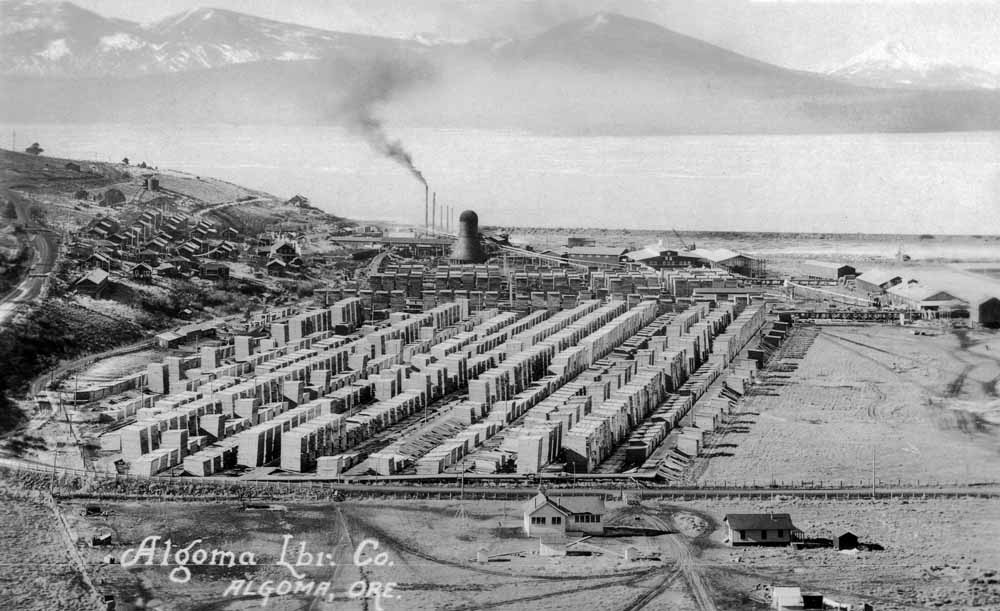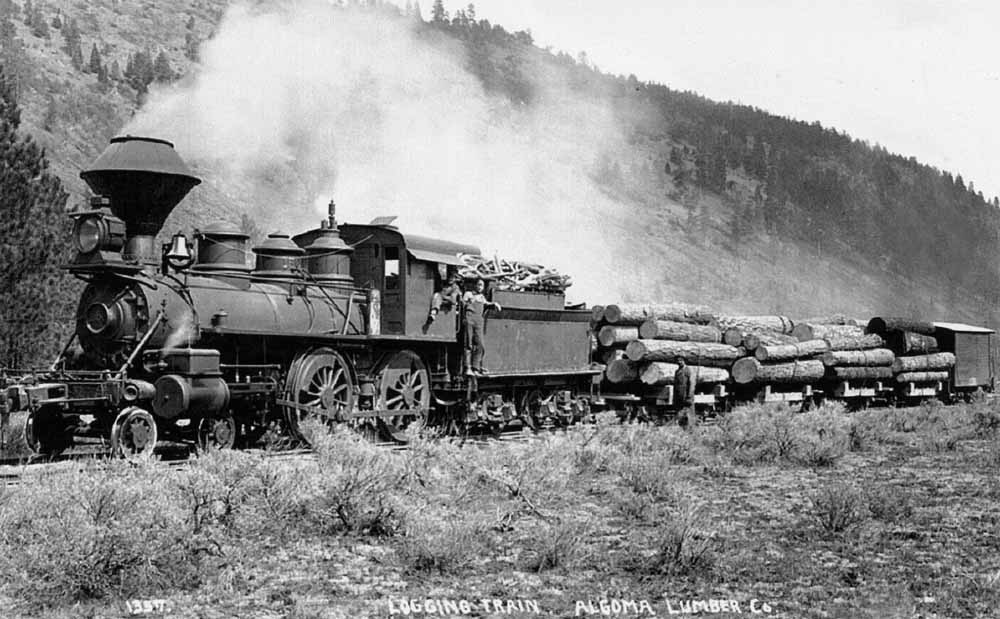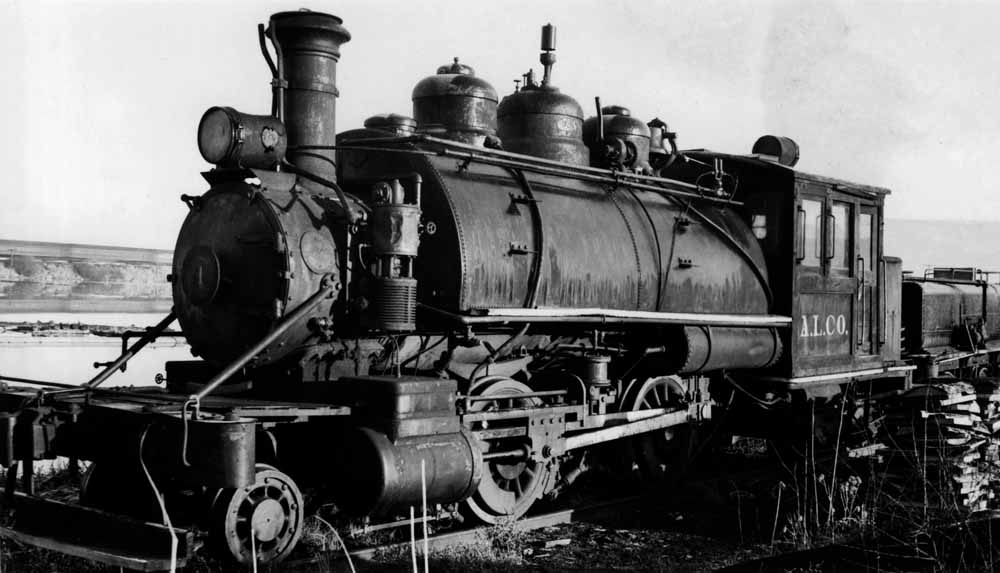|
Algoma Lumber Company |
|
|
 |
|
Algoma Lumber Company #1506, the Helen Grant, in Plum Valley about 1915. Jeff Moore collection.
|
|
|
|
History The Algoma Lumber Company got its start as a joint venture between Frank Paige Fay and his nephew E.J. Grant. The company initially existed primarily to supply Fay's Faye Fruit Company with box shook, the industy term for the pieces of a wooden shipping box that would be shipped bundled together from a box factory to the point of use, where the pieces would be assembled into a box. In 1905 Algoma built a box factory adjacent to a sawmill operated by the Bridgeford-Cunningham Lumber Company at Algomah on the line of the McCloud River Railroad Company in northeastern California. Algoma filed a lawsuit against the Bridgeford-Cunningham company in early 1907 after learning B-C operated the mill and timberlands and a lessee, when in fact they had represented themselves as owning the operations at the time the two parties signed the original agreement. That development apparently caused Algoma to start looking elsewhere, and they shortly built or bought a box factory at Montague, California. The Montague factory needed a lumber source, and instead of contracting lumber from a sawmill Algoma decided to enter the lumber manufacturing business directly. Algoma located some timberlands and a sawmill site near New Pokegama, at the end of the Klamath Lake Railroad. The sawmill opened in 1908 and started shipping lumber over the Klamath Lake and Southern Pacific railroads to the Montague box factory. The operation, including logging railroads built into the timber, operated successfully until 1911 when the timber ran out. Algoma initially purchased the small 0-4-2T locomotive named Old Blue and four log cars from the Pokegama Sugar Pine company, later supplemented by an ancient 1872-built 4-4-0 purchased from the Southern Pacific and named the Helen Grant in honor of E.J. Grant's wife. The end of operations at Pokegama forced Algoma to look for a new home for their operations. The company quickly found a new sawmill site at Rattlesnake Point north of Klamath Falls, and it brought the Helen Grant, the four log cars, and the rails from Pokegama to the new site. Algoma also moved the Montague box factory north to the new sawmill as well to consolidate all of their operations to a single plant. The new sawmill opened in 1914. The company's first logging railroad ran up Plum Valley to the southeast of the mill, but access to any further timber required the company to build a 2,600-foot long incline that ran up the side of an 800-foot tall rimrock cliff near the sawmill, which they completed in 1915. The logging railroads spread out north and south from the top of the incline. Logging remained active in that area until 1918, when the timber ran out. Algoma's next move took it north to Kirk and to a large block of timber on the Klamath Indian Reservation the company won in 1917. Algoma promptly broke ground on a new logging railroad running west into the timber. Logging in this area lasted until 1929 when the timber was again exhausted. Southern Pacific supplied the log flats that hauled the logs from Kirk back south to Algoma. Algoma's final rail logging operation involved harvesting fire damaged timber plus another newly acquired block of timber in the Swan Lake and Antelope Valley areas, which required the company in late 1926 or early 1927 to rebuild the incline and several miles of the old logging railroads above the incline. A 1926 Lumber Industry Directory described Algoma's operations as follows: "Algoma Lumber Co., 205 Fay Bldg., Los Angeles, Cal.; camp post office, Algoma; daily output, 200M; 2 sides; 400 men; machine shop; commissary; electric light plant; air compressors; 1 McGiffert loader; 6 logging tractors; 6 sets big wheels; 24 horses; route supplies via Southern Pacific; camp telephone viat Klamath Falls; manager, E.G. Grant; superintendant and purchasing agent, Matt Egan; master mechanic, Fred Stewart; 10 miles s.g. track; 60 lb. rail; 2 rod locomotives; 60 flat cars; 6 moving cars; maximum curvature, 4 degrees; locomotive fuel, oil; trucks and flat cars supplied by the Southern Pacific railroad." Algoma operations lasted until 1935, when the company shifted its operations to several more blocks of newly acquired timber, but delivering those logs to the mill was accomplished only by trucks and log rafts on Klamath Lake. Algoma sold the remaining timber above the incline and the railroad to Kesterson Lumber Company, who continued operating it until the timber ran out in 1941. The Algoma mill would only last another two years, as a lack of any additional timber to cut forced the mill to close forever on 11 April 1943. Concrete foundations from the mill, the grade of the incline and many miles of logging railroad grades, and at least one large trestle remnant mark the operation today. |
|
|
Maps |
|
An overview map showing the general location of the company's three rail operations.
|
 |
|
New Pokegama operating area, 1908-1911.
|
 |
|
Algoma/Rattlesnake Point operating area, 1914-1918 and then again 1926-1935
|
 |
|
Kirk operating area, 1917-1929.
|
|
|
|
Locomotive Roster
1:1- Baldwin 0-4-2T, c/n 9081, Built 1888. Built as Pasadena City Railroad #1, Pasadena, CA; to Klamath River Lumber Company #1, named Old Blue; to Pokegama Sugar Pine Lumber Company #1, ; to Pokegama Milling Company; to Algoma Lumber Company. Abandoned in woods near Pokegama after 1911, where it remained until scrapped around World War Two. 1:2- Baldwin 2-4-4T, c/n 34845, Built 1910. Cylinders 16x24, Drivers 46", Weight 55 tons. Built as Western Meat Company #4, South San Francisco, CA; to South San Francisco Belt Railway #4; to Algoma Lumber #1, named Peggy; to Modesto & Empire Traction #8, Modesto, CA; Scrapped 1908. 2- Baldwin 2-6-2T, c/n 43102, Built 1915. Cylinders 17x24, Drivers 44", Weight 65 Tons. Purchased new; to U.S. Army #L-4, Camp White, Oregon, 1942; Scrapped 9/1949 at South San Francisco, CA. 3- Tank engine, named Whop, no other details. 4- Lima 3-Truck Shay, c/n 2754, Built 1914. Cylinders 12x15, Drivers 35", Weight 79 tons. Built as Stephens-Bird Lumber & Log Company #4, Monroe, WA; to Algoma Lumber #4; to Klamath Timber Company (Kesterson Lumber Company) #4, Algoma, OR; to Oregon Ship Building #4, Portland, Oregon, 1944. 1506- Baldwin 4-4-0, c/n 2935, Built 1872. Built as Oregon & California Railway #15; to Southern Pacific #1251, then #1506; to E.T. Abbot #1506; to Algoma Lumber #1506, possibly may have carried #3 as well, plus name Helen Grant. Scrapped at Algoma circa 1938. |
|
|
|
Photos |
 |
|
A postcard view of the Algoma Lumber Company sawmill. Jeff Moore collection.
|
 |
|
A partial view of the Algoma Lumber #1506. John T. Labbe Collection of Logging and Railroad Photographs, 1892-2010, Washington State Archives,
Digital Archives, http://www.digitalarchives.wa.gov.
|
 |
|
A slightly less cropped view of the #1506 that shows the small four wheel caboose the operation also used in its early years. Jeff Moore collection.
|
 |
|
Robert M. Hanft caught this image of the Algoma Lumber #1 at Algoma in 1946. John T. Labbe Collection of Logging and Railroad Photographs, 1892-2010, Washington State Archives,
Digital Archives, http://www.digitalarchives.wa.gov.
|
 |
|
Algoma Lumber #2 at Kirk. John T. Labbe Collection of Logging and Railroad Photographs, 1892-2010, Washington State Archives,
Digital Archives, http://www.digitalarchives.wa.gov.
|
 |
|
An R.C. Moulton photo of Kesterson Lumber's former Algoma Lumber #4 in June 1939. John T. Labbe Collection of Logging and Railroad Photographs, 1892-2010, Washington State Archives,
Digital Archives, http://www.digitalarchives.wa.gov.
|
 |
|
David Moore, my grandfather, shot this photo looking north from the top of Rattlesnake Point sometime around 1946. The Algoma mill and town once lay at the
foot of the hill in the foreground, and the incline site is out of view to the right. The fill carrying the Southern Pacific main line cuts through the middle of the photo, and the
old Algoma log pond is still being used by someone to store logs at this late date.
|
 |
|
The hoisting engine at the top of the Algoma Incline. Jeff Moore collection.
|
 |
|
The scar of the Algoma incline in March 2016. Jeff Moore photo.
|
|
|